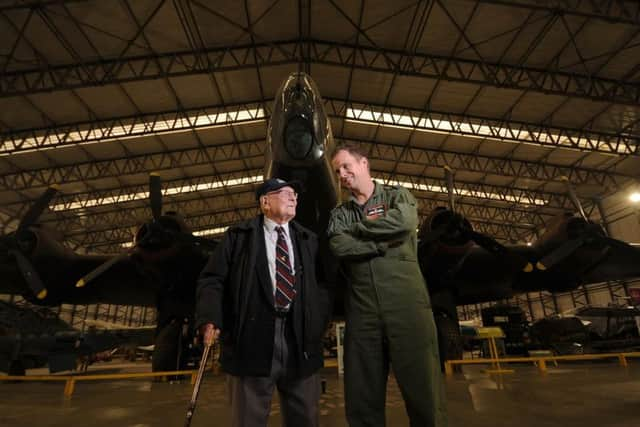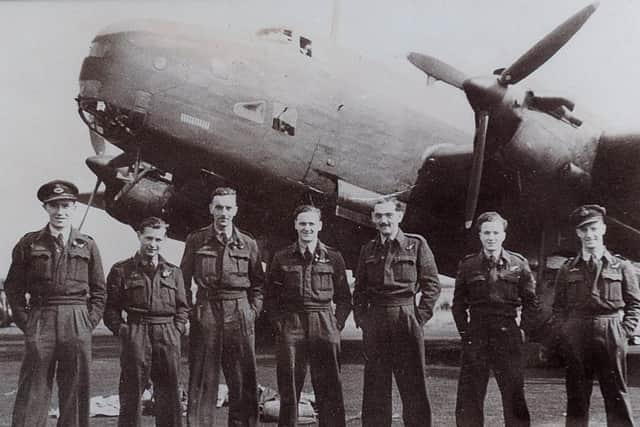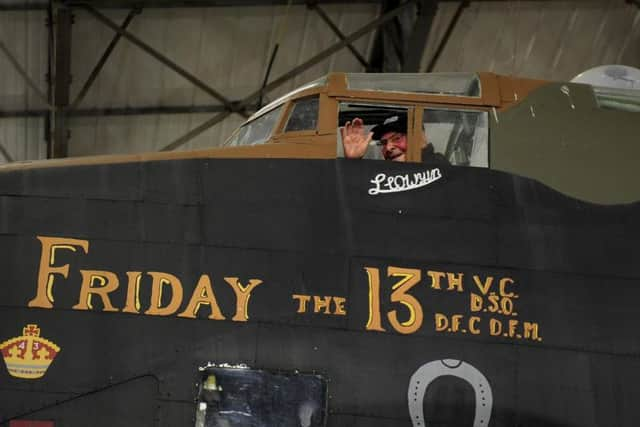Second World War veteran reunited with Halifax bomber for 80th anniversary of maiden flight at Yorkshire Air Museum
“We were just doing our jobs and we didn’t think we were being brave,” he said.
-> Humbling Second World War stories of region’s D-Day veterans deserve to be told - The Yorkshire Post saysBut the Distinguished Flying Cross recipient, 97, relived memories of airborne combat during 80th anniversary celebrations for the Handley Page Halifax bomber at the Yorkshire Air Museum in Elvington near York yesterday – setting foot in the aircraft for the first time since Egypt in 1947.
Advertisement
Hide AdAdvertisement
Hide AdThe plane’s maiden flight, as a prototype, was on October 25 1939 and to mark the milestone, Flt Lt Dunn was invited to the museum with current RAF pilot Flt Lt Daniel Whatmough.


Flt Lt Dunn was almost 17 when the war began, and shortly after joined the Home Guard.
He began his air force career in 1941 at RAF Chatham careers office in Kent, where Mr Whatmough would make his own start some 65 years later.
The elder went on to learn to fly in the UK and Canada under the Empire Air Training Scheme, and then on to experiencing the Halifax with the 76 squadron at RAF Linton-on-Ouse and later Holme-on-Spalding-Moor.
Advertisement
Hide AdAdvertisement
Hide AdHe was involved in the bombing of Hamburg during Operation Gomorrah and then the top-secret mission to strike the formidable Nazi-German V weapon development site in Peenemünde in 1943.


-> What long-lost Second World War letters reveal about life at home for Yorkshire womenThe latter mission was called Operation Hydra and of the 596 aircraft launched for the raid, 40 failed to return. It was the first time a ‘master bomber’ - Group Captain JH Searby of 83 squadron – directed such an attack.
In reference to one flight, Flt Lt Dunn said: “I was in the back in the rest position whilst we were taking off and landing and just moved up when he (another pilot) vacated it. He told me in no uncertain terms that was is place on take-off and landing and I could have it in between.”
Flt Lt Whatmough joked that was “during the dangerous stuff,” and Mr Dunn replied “yes”.
Advertisement
Hide AdAdvertisement
Hide AdAfter the Halifax, Flt Lt Dunn went on to fly Mosquitos on 608 squadron with the Light Night Striking Force, holding pathfinder duties and taking part in raids on Berlin.


He was posted to Egypt to test fly aircrafts after hostilities ceased. On being told to test a Spitfire, Flt Lt Dunn pointed out he was a ‘multi-engine’ pilot. “Here are the pilot’s notes, you’ll soon get the hang of it,” he was told. He flew a Spitfire that he would meet again 72 years later.
Flt Lt Whatmough spent six years as an RAF Navigator flying with the Tornado GR4 before being selected to train as a pilot on the same 76 squadron as Flt Lt Dunn 10 years ago. He said:
“Being here today with someone so special as George is an absolute honour, and to hear the stories of what George and his crew went through in Halifax aircraft such as this is truly incredible. It was important for me to get George here today, to remember the incredible effort and bravery that these men once gave.”
Advertisement
Hide AdAdvertisement
Hide Ad-> Youngest British serviceman to die in Second World War to get memorial recognition in Ossett hometownThe example of the Halifax at Yorkshire Air Museum in the East Riding is the first of only two recreated examples of the aircraft to be seen in the world – none of the surviving planes were salvaged after the war.
The Halifax started full production into service with the RAF Bomber Command on November 13 1940.
In line with the tradition of naming bomber aircraft after large industrial towns, the name of Halifax was given and Lord and Lady Halifax officiated the naming ceremony in September 1941 when the politician was British Ambassador to the United States.
Some 6,176 production aircraft were built for service. They flew 82,773 operations, deploying 224,207 tons of bombs.
However, 1,833 of these aircraft were lost in action.